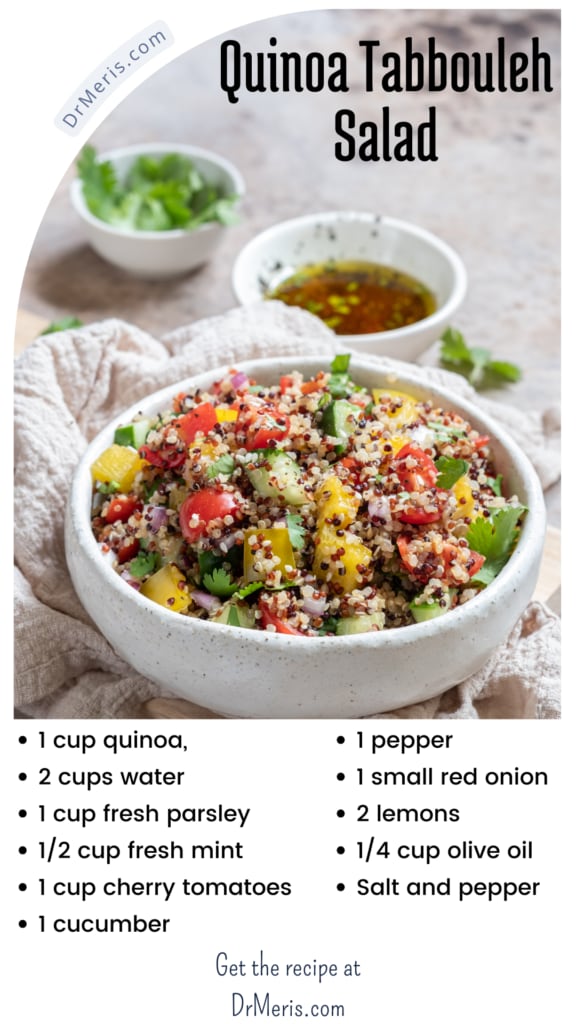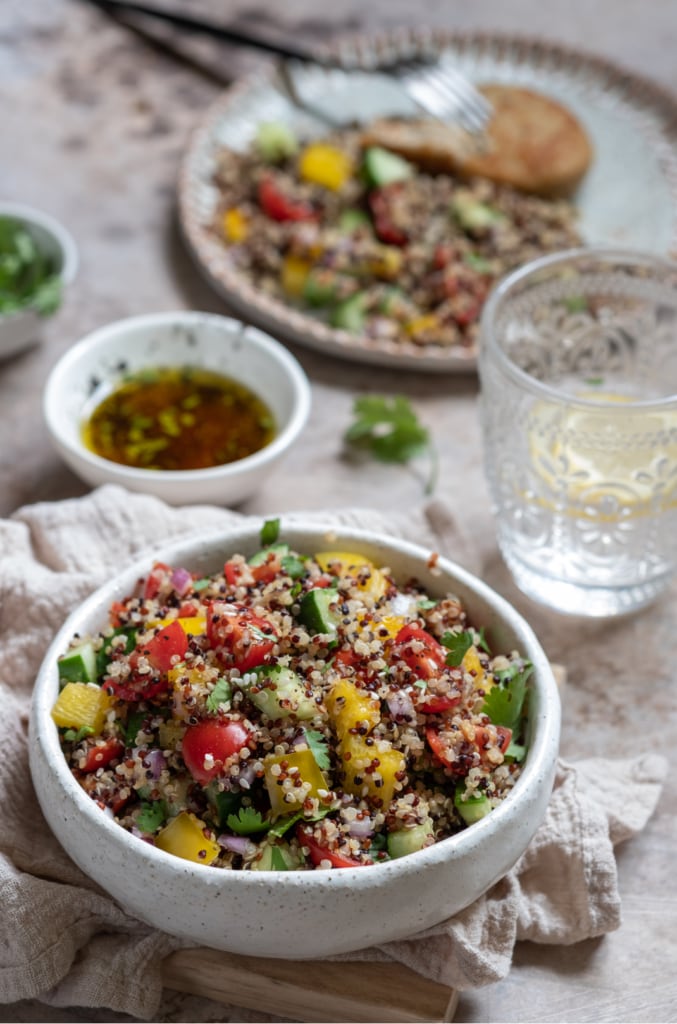Quinoa Tabbouleh Salad
Quinoa Tabbouleh Salad is a healthier version of the classic Middle Eastern salad, using quinoa instead of bulgur wheat to make it gluten-free and protein-rich.

Key Ingredients
- Quinoa: A high-protein, gluten-free grain that serves as the base. For this recipe, I used fresh mixed quinoa (white, red, and black quinoa).
- Fresh Herbs: Parsley and mint are essential for the fresh flavor profile.
- Vegetables: Common additions include diced cucumbers, tomatoes, peppers, and red onions.
- Dressing: Typically made with lemon juice, olive oil, salt, and pepper.
Nutritional Benefits
- High in Protein: Quinoa is a complete protein, providing all nine essential amino acids.
- Rich in Fiber: Helps with digestion and keeps you feeling full.
- Packed with Vitamins: Fresh vegetables and herbs provide vitamins A and C, among others.
Health Benefits of Quinoa
Quinoa is a highly nutritious grain that offers a variety of health benefits. Here are some key advantages of including quinoa in your diet:
- High in Protein: Quinoa is one of the few plant-based foods that is a complete protein, containing all nine essential amino acids. This makes it an excellent choice for vegetarians and vegans.
- Rich in Fiber: Quinoa is a good source of dietary fiber, which aids digestion, promotes satiety, and can help manage weight.
- Gluten-Free: Naturally gluten-free, quinoa is a great alternative for those with gluten sensitivities or celiac disease.
- Packed with Nutrients: Quinoa is rich in vitamins and minerals, including magnesium, phosphorus, manganese, and B vitamins, which are essential for various bodily functions.
- Antioxidant Properties: Quinoa contains antioxidants, such as quercetin and kaempferol, which can help reduce inflammation and protect against chronic diseases.
- Heart Health: The fiber, potassium, and healthy fats in quinoa can contribute to lower blood pressure and cholesterol levels, supporting cardiovascular health.
- Blood Sugar Control: Quinoa has a low glycemic index, which can help stabilize blood sugar levels, making it a good choice for those with diabetes.
- Versatile and Easy to Prepare: Quinoa can be used in a variety of dishes, from salads to soups to side dishes, making it easy to incorporate into your diet.
- Supports Bone Health: Quinoa is a good source of magnesium, which is important for bone health.
- Promotes Healthy Skin: The antioxidants and anti-inflammatory properties can contribute to healthier skin.
Incorporating quinoa into your meals can enhance both flavor and nutritional value, making it a smart choice for a balanced diet!
What’s the Difference between White, Black, and Red Quinoa?

Quinoa comes in several varieties, with white, black, and red being the most common. Here are the key differences among them:
1. Color and Appearance:
- White Quinoa: The most common variety, it has a light color and a slightly nutty flavor. It cooks to a fluffy texture and is often used in a variety of dishes.
- Black Quinoa: This variety has a darker color and is known for its slightly sweeter, earthier flavor. It retains its shape well when cooked and has a firmer texture compared to white quinoa.
- Red Quinoa: This variety is reddish-brown and has a slightly more robust flavor than white quinoa. It also has a chewier texture and retains its shape better, making it great for salads.
2. Nutritional Differences:
- Protein Content: All varieties are high in protein, but red and black quinoa may contain slightly higher levels of certain nutrients and antioxidants.
- Fiber: All types provide a good amount of fiber, but black and red quinoa can have higher fiber content due to their hulls being more intact.
- Antioxidants: Black and red quinoa are richer in antioxidants compared to white quinoa, contributing to their health benefits.
3. Cooking Time and Texture:
- Cooking Time: White quinoa cooks the fastest, usually in about 15 minutes, while black and red quinoa may take a bit longer (around 20 minutes) due to their tougher hulls.
- Texture: White quinoa becomes fluffy and light, while black and red quinoa have a crunchier texture and hold their shape better, making them ideal for salads or as a side dish.
4. Culinary Uses:
- White Quinoa: Versatile and mild in flavor, it can be used in a wide range of dishes, from salads to grain bowls.
- Black Quinoa: Great for adding color and texture to salads or grain dishes, it pairs well with earthy flavors.
- Red Quinoa: Often used in salads and as a base for dishes where a more robust texture is desired.
Summary
All three varieties of quinoa are nutritious and delicious, so the choice often comes down to personal preference and the specific dish you’re preparing! Mixing them can also create a visually appealing and flavorful dish.
Serving Suggestions:
Quinoa tabbouleh can be served as a refreshing side dish, a light lunch, or a main course when paired with additional protein, like grilled chicken or fish. It's also great for meal prep, as the flavors meld beautifully when allowed to sit in the fridge for a while.
Overall, it’s a vibrant, healthy dish that’s perfect for warm weather!

Tips:
- Adjust the herbs and vegetables to your taste.
- This salad is great as a side dish or a light main course and can be stored in the fridge for a few days!
- You may use vegetable broth instead of water to make your salad even more nutritious.
Check out:
Quinoa Tabbouleh Salad is a nutritious twist on the traditional Middle Eastern tabbouleh, which typically uses bulgur wheat as its base. In this version, quinoa replaces bulgur, making it gluten-free and adding a good source of protein.
- 1 cup quinoa (rinced)
- 2 cups water or vegetable broth
- 1 cup fresh parsley (finely chopped)
- 1/2 mint (finely chopped)
- 1 cup cherry tomatoes (diced)
- 1 cucumber (diced)
- 1 large red pepper (or yellow)
- 1 small red onion (finely chopped)
- Juice of 2 lemons
- 1/2 cup olive oil
- salt and pepper (to taste)
- Cook the Quinoa:
In a medium saucepan, combine the quinoa and water (or broth). Bring to a boil, then reduce the heat to low, cover, and simmer for about 15 minutes or until the quinoa is fluffy and the liquid is absorbed. Remove from heat and let it cool.
- Prepare the Vegetables
While the quinoa is cooling, chop the parsley, mint, cherry tomatoes, pepper, cucumber, and red onion.
- Combine Ingredients:
In a large bowl, combine the cooked quinoa, parsley, mint, tomatoes, pepper, cucumber, and red onion.
- Make the Dressing:
In a small bowl, whisk together the lemon juice, olive oil, salt, and pepper. Pour over the salad and toss gently to combine.
- Serve:
Serve immediately or refrigerate for about 30 minutes to let the flavors meld.
Enjoy your refreshing Quinoa Tabbouleh Salad!
Here are the estimated nutrition facts for a serving of Quinoa Tabbouleh Salad (based on a recipe serving about 4):
Nutrition Facts (per serving):
- Calories: ~220
- Protein: ~6g
- Fat: ~10g
- Saturated Fat: ~1g
- Carbohydrates: ~28g
- Dietary Fiber: ~5g
- Sugars: ~2g
- Vitamin A: ~20% of the Daily Value (DV)
- Vitamin C: ~30% of the DV
- Calcium: ~4% of the DV
- Iron: ~10% of the DV
Note:
- These values can vary based on specific ingredients and portion sizes.
- To adjust the nutrition profile, consider using less olive oil or adding more vegetables.
This salad is a great source of plant-based protein, healthy fats, and dietary fiber, making it a nutritious option for a light meal or side dish!



